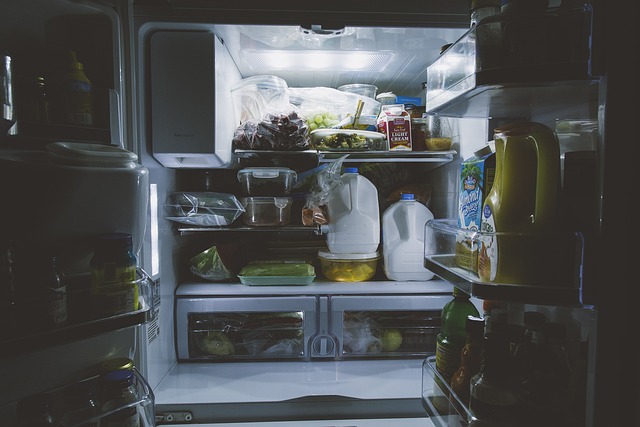When considering an upgrade to a more energy-efficient refrigerator, it's important to assess your current model's performance by checking its Energy Star rating and considering its lifespan and repair history. A refrigerator that frequently needs repairs might be better replaced than repaired for long-term cost savings. Evaluate if the fridge's capacity matches your storage needs, as a larger model may offer better energy efficiency without leading to unnecessary energy use. Compare the energy consumption of different models, noting their advanced cooling systems and improved insulation, which contribute to their enhanced energy efficiency. Understanding these factors helps determine whether to repair or replace your refrigerator, with the latter often being more cost-effective in the long run due to significant energy savings.
Energy-efficient innovations in new refrigerators, such as better insulation and Energy Star certification, can lead to substantial reductions in energy consumption and costs for both residential and commercial users. These upgrades not only improve performance but also offer financial advantages by lowering operational expenses. Investing in these models is often justified, as the savings on utility bills can offset the initial cost within a few years. Additionally, such refrigerators typically require less frequent repair due to their robust construction, further contributing to their long-term value. The environmental impact is also reduced, aligning with conservation efforts and promoting sustainable practices. Regular maintenance and prompt refrigerator repair services are essential for maximizing energy efficiency and ensuring that the financial and ecological benefits are fully realized. For those who prefer DIY approaches or encounter issues, professional refrigerator repair services are available to assist with complex retrofitting processes and technical support. Regular cleaning of condenser coils, maintaining door seals, and addressing repairs swiftly are key to sustaining the efficiency and lifespan of your energy-efficient refrigerator.
energy efficiency, refrigerator upgrade, cost savings, energy-efficient components, refrigerator installation, refrigerator repair, maintenance longevity.
Homeowners and businesses alike are increasingly turning to energy-efficient appliances to reduce utility costs and their environmental footprint. This article delves into the transformative impact of installing energy-efficient components in your refrigerator. We’ll guide you through assessing your current fridge’s performance, understanding how these upgrades contribute to cost savings, and providing a detailed installation process for enhancing your appliance’s efficiency. Additionally, we’ll explore maintenance strategies and repair tips to ensure your investment remains an asset to your budget and sustainability goals over time.
- Assessing Your Current Refrigerator Efficiency and Needs for Upgrade
- The Role of Energy-Efficient Components in Refrigerators and Cost Savings
- Step-by-Step Guide to Installing Energy-Efficient Components in Your Refrigerator
- Maximizing the Lifespan of Your Energy-Efficient Refrigerator Through Maintenance and Repair
Assessing Your Current Refrigerator Efficiency and Needs for Upgrade

When considering an upgrade to your refrigerator for enhanced energy efficiency, a thorough assessment of your current appliance’s performance is crucial. Evaluate your existing unit’s efficiency by examining its Energy Star rating, which indicates how energy-efficient it is compared to newer models. Look into the lifespan and history of repairs your refrigerator has undergone; frequent maintenance might signal a need for a replacement rather than continuous fixes. Assessing the size of your household against the capacity of your fridge also plays a role in determining if an upgrade is necessary. A larger fridge might be more energy-efficient per cubic foot, but if it exceeds your storage requirements, you could end up using more energy than needed. Energy consumption can vary significantly between models, so it’s important to consider the specific features and technologies that contribute to efficiency, such as advanced cooling systems and improved insulation materials. By understanding your current refrigerator’s efficiency and identifying its shortcomings, you can make an informed decision about whether a repair or an upgrade to a more energy-efficient model is the best course of action for cost savings in the long term. Keep in mind that while occasional repairs are manageable, investing in a highly efficient refrigerator can lead to substantial energy savings over time, offsetting the initial cost of the new appliance.
The Role of Energy-Efficient Components in Refrigerators and Cost Savings

Energy-efficient components in refrigerators play a pivotal role in optimizing electricity consumption and enhancing overall cost savings for households and businesses alike. Modern refrigerator designs often incorporate advanced insulation materials, energy-star rated appliances, and sophisticated cooling technologies that significantly reduce the amount of energy required to maintain optimal temperatures. By integrating these components, refrigerators can achieve better performance while minimizing operational costs, a key consideration for consumers mindful of their energy usage and expenses.
When a refrigerator operates efficiently, it translates into tangible savings on utility bills. The initial investment in energy-efficient models, such as those that require less frequent refrigerator repair due to robust construction and design, can lead to long-term financial benefits. Homeowners and businesses can expect to see a return on their investment within a few years, as the cumulative energy savings offset the cost of the appliance. Moreover, these components not only conserve energy but also contribute to a reduced carbon footprint, making them an environmentally responsible choice that aligns with sustainability goals. Regular maintenance and timely refrigerator repair further ensure that these appliances continue to operate at peak efficiency, safeguarding the ongoing financial and environmental benefits they provide.
Step-by-Step Guide to Installing Energy-Efficient Components in Your Refrigerator

When considering the installation of energy-efficient components in your refrigerator, it’s a process that requires careful attention to detail and adherence to manufacturer guidelines. A malfunctioning or outdated refrigerator can significantly increase your energy bills, so upgrading to more efficient parts can lead to substantial cost savings over time. To begin, assess the current state of your refrigerator. Determine whether it’s a candidate for energy-efficient component upgrades by checking its model, age, and existing components. If it’s an older model, it might be more economical in the long run to replace rather than repair, especially if repairs are extensive.
For those with a refrigerator suitable for retrofitting, start by gathering the necessary tools and parts. Common upgrades include energy-efficient cooling units, better door seals, and LED lighting. Ensure you have a multi-meter, screwdrivers, and safety glasses on hand. Next, carefully remove the old components. Replace the door gasket if it’s worn out to prevent cold air from escaping. Install the new energy-efficient lighting, which typically involves disconnecting the power supply, removing the old bulbs, and fitting the new LED lights, ensuring they are properly secured and connected according to their specifications. After that, replace the cooling unit if it’s an older model that consumes a lot of energy. This step may require the most technical expertise, as it involves disconnecting the refrigerator from its power source, accessing the cooling unit, and installing the new, more efficient component. Finally, reassemble the refrigerator, ensuring all parts are securely fastened. After completing the installation, plug the refrigerator back in and test to make sure it’s operating efficiently. Keep an eye on your energy consumption to confirm that the upgrades have resulted in cost savings. Regular maintenance will help ensure these benefits are sustained over time. Remember, if you’re ever unsure about any step in the process, professional refrigerator repair services can assist with the more complex aspects of this upgrade.
Maximizing the Lifespan of Your Energy-Efficient Refrigerator Through Maintenance and Repair

Regular maintenance is a critical aspect in maximizing the lifespan of your energy-efficient refrigerator. By following a routine schedule for cleaning the coils, checking door seals, and ensuring proper airflow, you can maintain the unit’s efficiency and extend its operational life. Dust and debris accumulation on the condenser coils can impede heat transfer, causing the refrigerator to work harder and consume more energy. A simple task of vacuuming or cleaning these coils regularly can prevent this issue. Similarly, faulty door seals lead to poor insulation and increased energy usage; regular inspections and timely repairs can prevent significant energy loss.
In the event that your refrigerator requires repair, addressing issues promptly is essential for maintaining its efficiency. Common problems such as a noisy compressor, a malfunctioning thermostat, or a faulty door switch should be diagnosed and fixed by a qualified professional to avoid further energy consumption and potential breakdowns. Utilizing specialized services for refrigerator repair can ensure that any necessary repairs are performed correctly, employing the right parts and techniques to return your energy-efficient appliance to optimal performance. Proactive maintenance and swift repairs play a pivotal role in preserving the longevity and effectiveness of your energy-saving refrigerator.
Refrigerator repair and upgrades to energy-efficient components can lead to significant cost savings while ensuring optimal refrigerator performance. By carefully assessing your current unit’s efficiency and considering an upgrade, homeowners can benefit from reduced energy consumption and lower utility bills. The installation process, detailed in the article, empowers users with the knowledge to perform refrigerator repair or enhancements themselves, ensuring both cost-effectiveness and long-term reliability. Regular maintenance and timely repairs further extend the lifespan of your efficient appliance, making it a smart investment for any household aiming to reduce their carbon footprint and save money in the long run. Implementing these strategies is key to harnessing the full potential of energy-efficient refrigerators.
